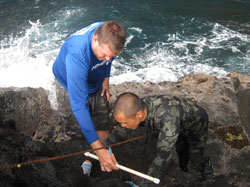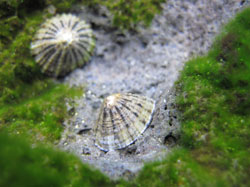
Intertidal Monitoring Cruise Departs to Papahānaumokuākea

Intertidal Monitoring Team members brave the rocky shorelines to conduct surveys. Credit: Shauna Kehaunani Springer
On Wednesday, September 12, 2012, an interdisciplinary team of both western and Native Hawaiian cultural researchers departed aboard the M/V Searcher to conduct research in the Papahānaumokuākea Marine National Monument. This is the fourth consecutive year of conducting research and monitoring activities on the rocky shorelines of Nihoa Island, Mokumanamana Island, and French Frigate Shoals in the Northwestern Hawaiian Islands.
The monitoring team consists of participants from Texas A&M University, the Scripps Institute of Oceanography, The Nature Conservancy, Nā Maka o Papahānaumokuākea, Conservation International-Hawaiʻi Fish Trust, Kahoʻolawe Island Reserve Commission, Kalapana Fishing Council, Nā Mamo o Muoleʻa and Kipahulu ʻOhana.
The team will carry out various activities within the little-explored intertidal zone (the area that is above water at low tide and under water at high tide), including:
- Transects from the highest to lowest tide marks to record the number and types of algae and invertebrates found
- Research on ʻopihi (limpet) spawning behavior
- Collection of algae and invertebrates for DNA analysis
- Collection of Hyposmocoma moths on behalf of Dr. Daniel Rubinoff of University of Hawaiʻi (in 2007, seven new species of endemic moths were discovered on Nihoa and Mokumanamana)
- Documenting observations of weather and animal interactions to gain further information on atmospheric and seasonal cycles from a Native Hawaiian perspective
The final activity was added to the annual expedition last year to further work toward the Monument's mission to integrate western research activities with Native Hawaiian cultural research.
Compared to the main Hawaiian Islands, the rocky shorelines within the Monument are pristine and host many species of invertebrates, fish, and seaweeds. However, data on species abundance and presence/absence within the intertidal zone in the Northwestern Hawaiian Islands has only relatively recently been systematically collected.
These shorelines were historically important; while the men fished out at sea, Native Hawaiian women negotiated the intertidal zone to gather ʻopihi and haʻukeʻuke (helmet urchin) – the flesh used for food and shells used as tools for scraping kalo (taro) and niu (coconut) and imprinting kapa cloth. In reverence to this Native Hawaiian connection, researchers offer chants and small gifts of water and salt prior to conducting their research activities.
This year, the team will also focus on learning more about ʻopihi spawning activity in the hopes of improving ʻopihi management and restoration in the Monument as well as in populated areas like ʻOahu.
The team will spend 12 days in the Monument. The results of their expedition will be posted here.
Read about last year's Intertidal Monitoring cruise here.
